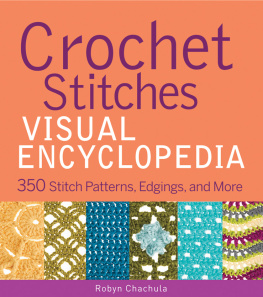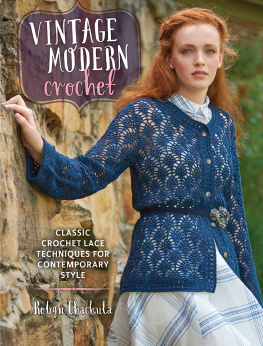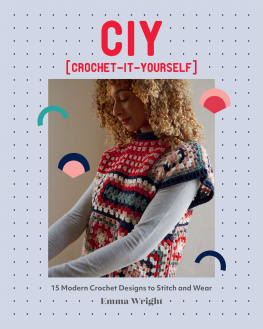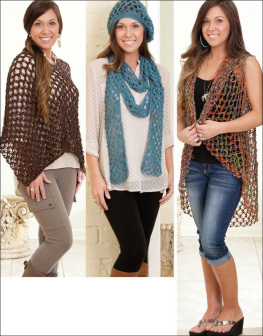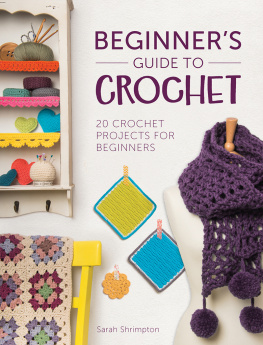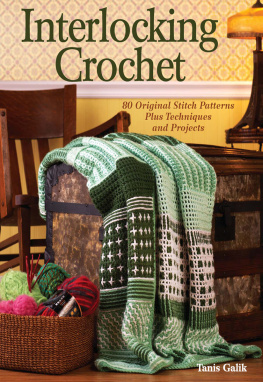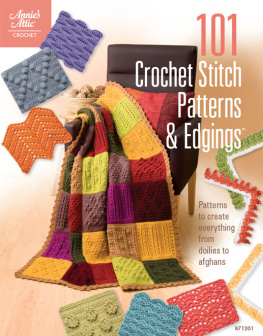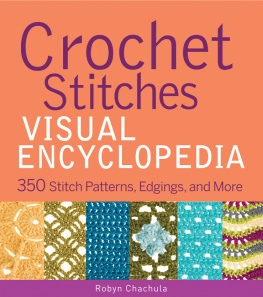Blueprint Crochet
Modern Designs for the Visual Crocheter

Robyn Chachula

Editor: Katrina Loving
Technical Editor: Julie Holetz
Art Direction and Design: Connie Poole
Photography: Brooks Freehill
Hair & Makeup: Catherine Corona
Special thanks to Prospect New Town, Longmont, Colorado.
Text 2008 Robyn Chachula
Photography 2008 Interweave Press LLC
Illustrations 2008 Interweave Press LLC
All rights reserved.

| Interweave Press LLC
201 East Fourth Street
Loveland, CO 80537-5655 USA
interweavebooks.com |
Library of Congress Cataloging-in-Publication Data
Chachula, Robyn, 1978
Blueprint crochet : modern designs for the visual crocheter / Robyn Chachula, author.
p. cm.
Includes index.
ISBN 978-1-59668-072-2 (pbk.)
ISBN 978-1-59668-946-6 (PDF)
ISBN 978-1-62033-248-1 (ePub)
1. Crocheting--Patterns. I. Title.
TT825.C378 2008
746.434041--dc22
2008008681
Acknowledgments
This book is the absolute icing on the cake for me in terms of fulfilling one of my childhood dreams. I did not do it alone, and there are many I would like to thank.
First and foremost, I would like to thank Interweave for taking a gamble on a relatively new but highly excited crochet designer and helping her learn the ropes along the way. To the yarn companies that graciously donated yarn, thank you so much for all your support and quick response to all my requests.
I had wonderfully crafty crocheters help me make a lot of the samples for the book, and thus let me rest and not be a zombie. They are Rochelle Kaplan (my mom, I know shes the best!), Rebecca DeSensi, Virginia Boundy, Chie OBriant, Wilma Keith, Rebecca Velasquez, Megan Granholm, Tiffany Roots, Michelle Grissam, and Cecily Keim.
Most important, I would like to thank my friends and family. All your thoughts and kind words have touched me very much these past few months. To Courtney, thank you for being my lifelong cheerleader, best friend, and sister. To my parents (all six of them), thank you for constantly supporting me. And to my family, Mark and Faye; you both mean more to me than I can ever express. Mark, I cannot tell you how blessed I am to have such an amazing partner for life. And yes, Faye, now we can go for a walk.
Dedication
To Faye, thank you for literally trotting into my life and changing it forever.

Table of Contents
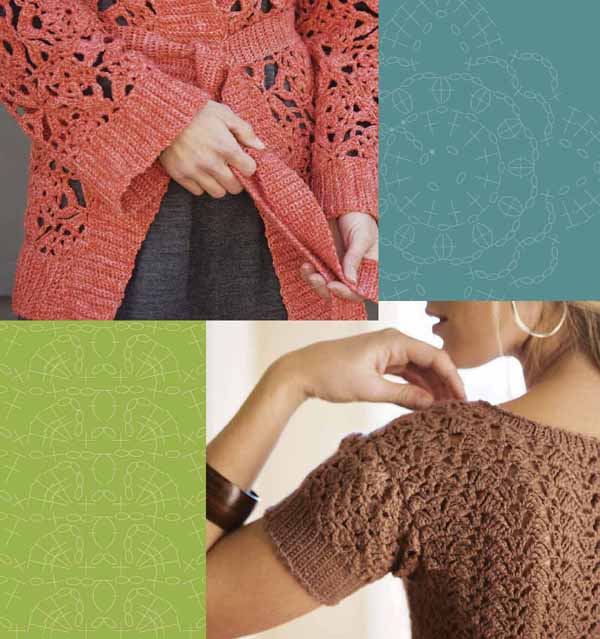

I have loved to crochet from the moment I picked up my first hook and ball of yarn. What I did not love right away was patterns. The jumble of abbreviations and words was just too much for my brain to process. It seemed that no matter how organized I was with crossing out rows I had finished or marking my place with post-it notes, I would still miss something and have to rip out. It got so frustrating that I decided to start designing my own projects, so I wouldnt miss a row or a stitch. The more I crocheted and designed the more I though there had to be a better way than the shorthand text that was being published.
It was about this time that I saw my first stitch dictionary with crochet symbols and at first glance I was hooked. I knew crochet diagrams and I were destined to go together, like peanut butter and jelly! For the first time, I could crochet a granny square and not get lost in the jumble of abbreviations. My immediate infatuation with diagrams comes from my daily life. I am a structural engineer, and every day I am working on drawings and details that show a picture of how the pieces of a building get put together. So when I finally saw symbol crochet and I could see what the stitch pattern looked like in a drawing, it was like I had found the blueprint into crochet that I had been searching for all that time. What I didnt realize then, was that a whole new world of crochet had just opened up to me. Now I could follow patterns from Japan, Portugal, and even Russia, not because I had learned three new languages, but because I could follow the crochet symbols without needing words.
My goal with this book is to open up this amazing new world of crochet to you as well and show you how easy and truly useful it is to use these diagrams. Along the way, I hope to entice you to crochet more and more of the patterns in the book by following the written words less and less, eventually relying solely on the crochet symbols. To help with this, I have gathered some of my favorite garments and accessories inspired by fashion magazines, by costumes in old 40s movies, and even by the quirky personalities in my family. In fact, you will notice along the way that I talk a lot about the women in my family because every pattern in this book is named after one of them. They are my support, my inspiration, and my source of creativity. So grab your hook and come join me on the sometimes kooky, but always fun adventure through Blueprint Crochet.
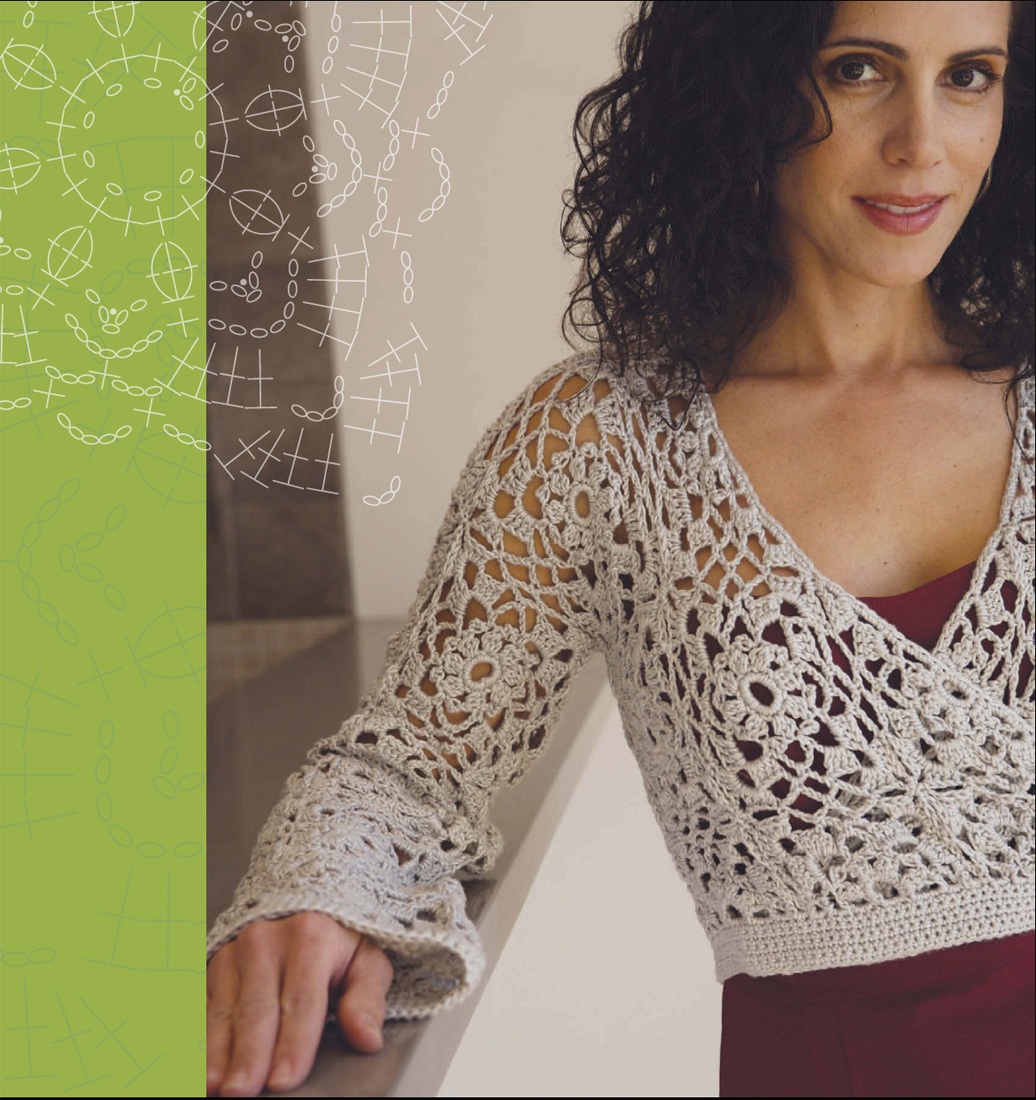

If you are anything like me, you will blow by this section and move straight to the good stuff, the patterns! But STOP! Dont be like me. Sit down for a second. In this book, you are going to see things that many crochet patterns dont have: crochet symbols. Dont worry, by the end of this chapter you will be wondering what the big fuss was about and how you were ever able to live without them. Really, trust me, you will like learning this new trick.
I am a visual person who works with graphics and drawings daily, so if you are anything like me you are going to love symbol crochet. The symbols have been around as long as crochet itself, although they may not always have looked exactly like what we use today. Symbols are a quick way to jot down the stitch pattern you are doing, and they allow you to see the big picture without photographs. They can also make a very complex pattern much easier to follow by simply showing you where to stitch.
A couple of years ago symbol crochet disappeared almost completely from American patterns. Thankfully, symbol crochet is becoming popular once again, thanks to computer programs that can easily generate the symbols, and global access to crochet design through the Internet. Designers, editors, and publishers are discovering the benefits of crochet symbols, including the international appeal of patterns that need no translation.

The key to understanding crochet symbols is that each symbol represents a crochet stitch. Yup, thats it. Its not rocket science; its more like doing a paint-by-number. All you have to do is learn which symbol is which stitch. At first glance, these little symbols may seem arbitrary, but take another look and you may find it easier to relate the symbols to the stitches. Consider the chain stitch, a simple oval symbol. Think about making a chain stitch: its a simple loop pulled through another loop. That loop looks a lot like an oval, right? Moving up the slip stitch is a filled-in dot; it is little and almost invisible, just like the stitch. The single crochet is a squat cross, again just like the stitch. Starting to see a trend? The half double crochet is slightly taller then the single crochet. The double crochet is taller then the half double, and it has an extra cross in its middle. From the double crochet up, the little cross tells you how many yarn overs you have before you insert your hook. Go ahead, make a double crochet. Now look at your stitch. Do you see the little cross in the middle of the stitch? Looks a lot like its symbol, huh? Each crochet symbol is actually a line-drawing replica of the shape and size of each stitch.
Next page

